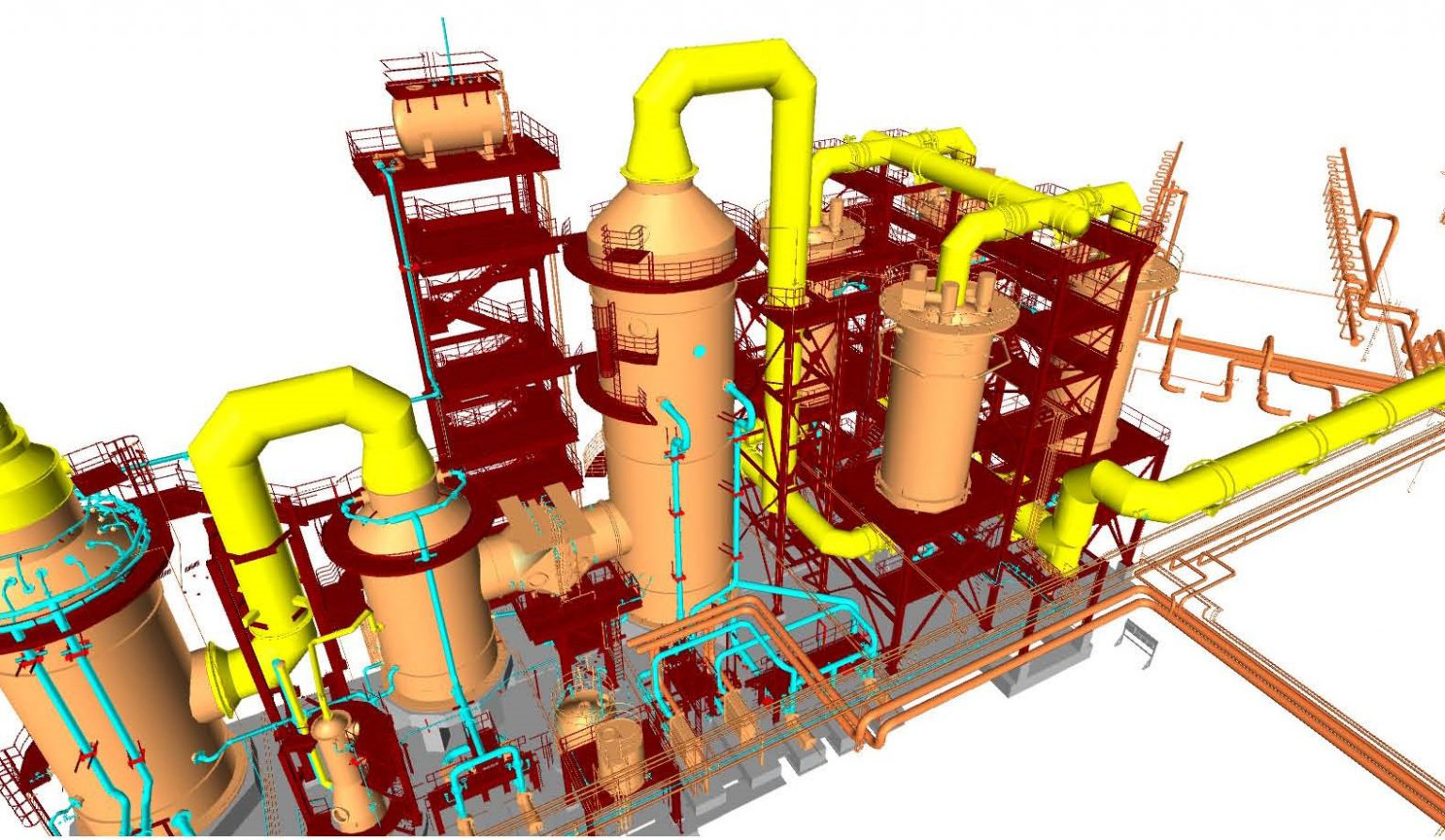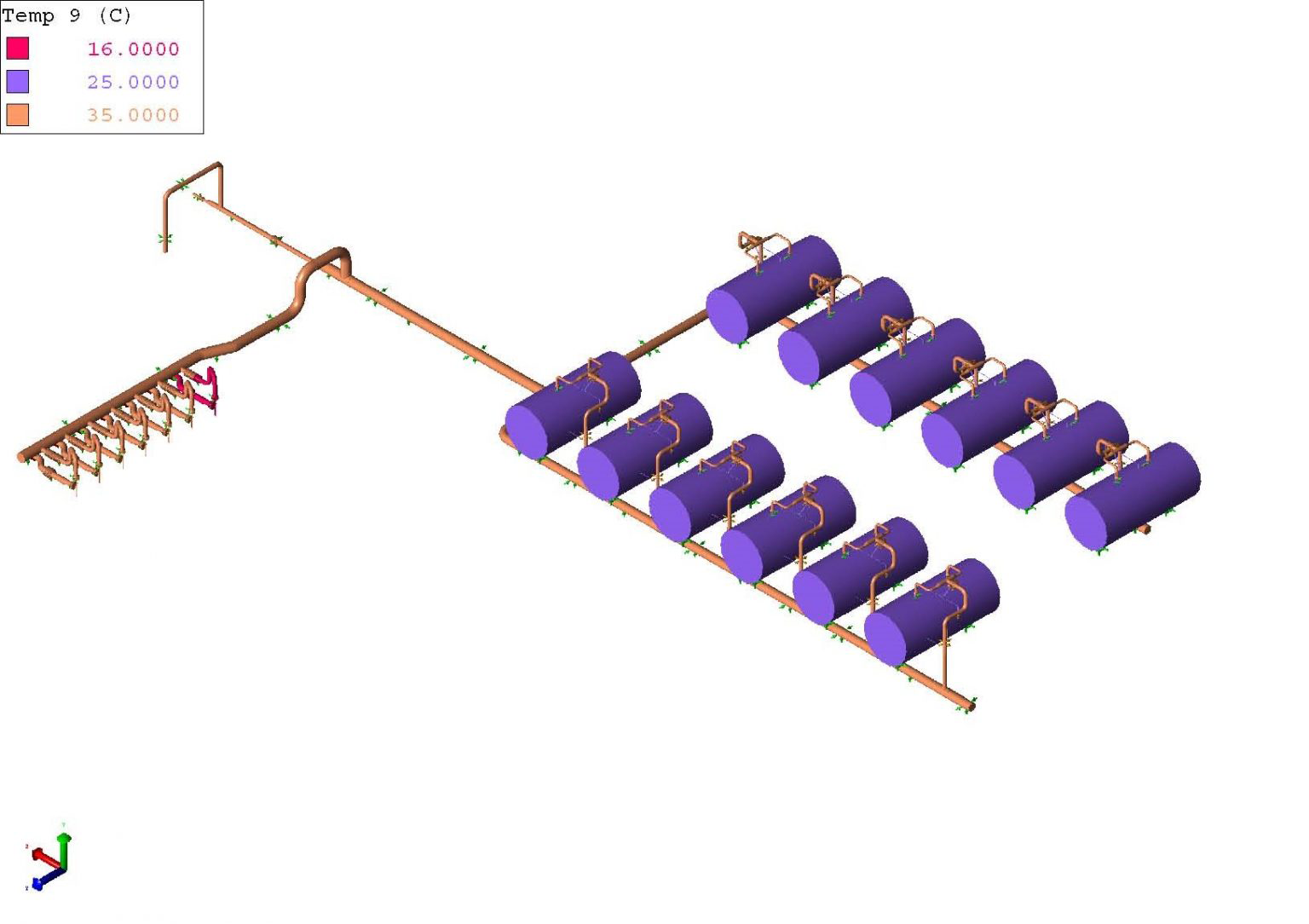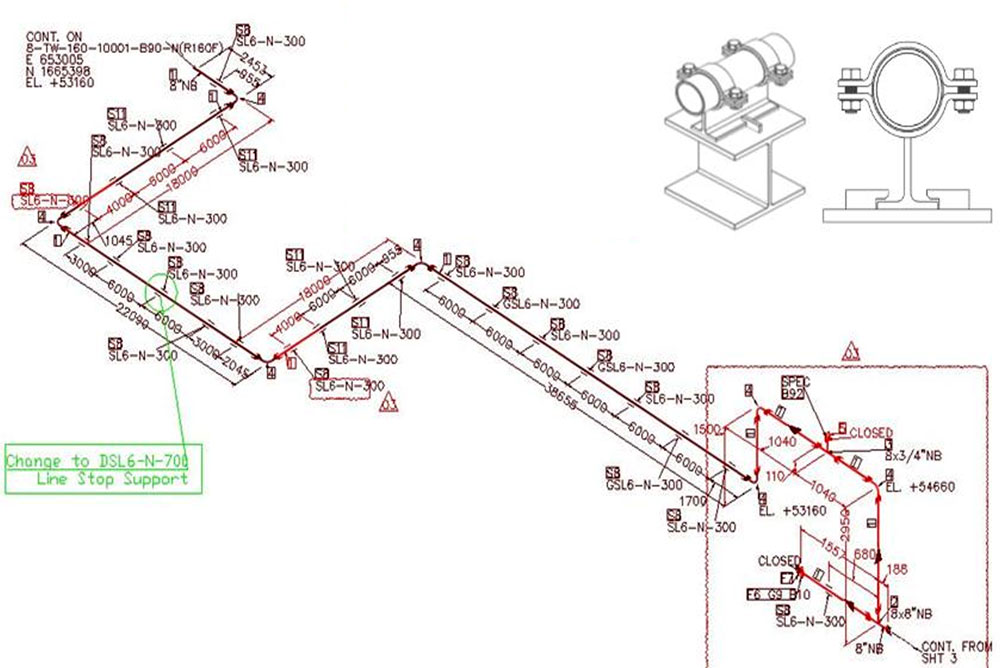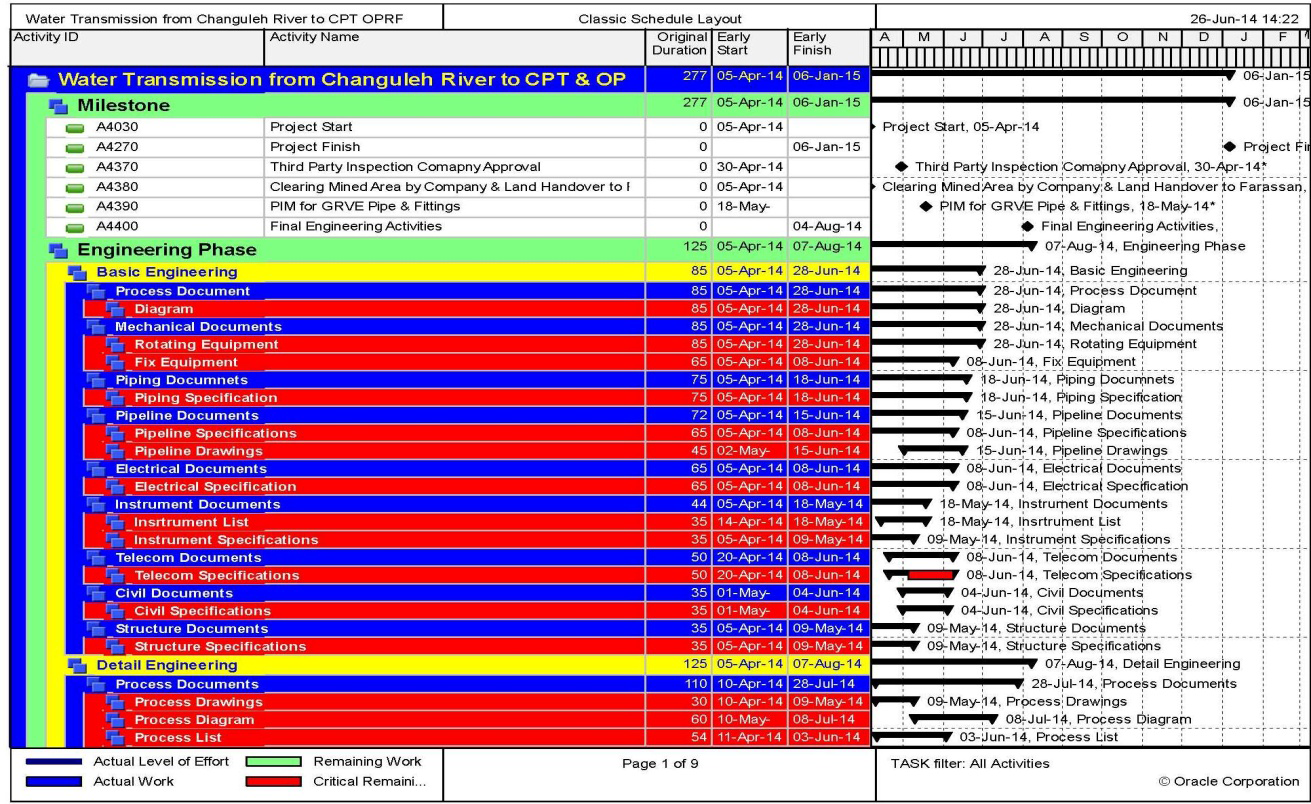Design and engineering services
Design and engineering services
1.Piping Department
1.Piping Department
Several types of software are used currently in order to design and model piping systems, among which one of the most complete and up-to-date software is PDMS.
The project site is modeled with all the details in PDMS, and the clash of the pipelines and their arrangement are modeled, then the isometric drawings and pipeline plan are prepared to construction on a millimeter base accuracy.
Therefore, accurate modeling of pipelines based on real dimensions is of great importance.
The design of process piping and arrangement of process equipment are performed in the piping department by PDMS. Because GRP material is special and production methods are different, manufacturing companies produce GRP pipes and fittings based on their own engineering calculations leading to different dimensions and specifications from the other manufacturers.
Therefor it is necessary in PDMS to use the exact dimensions of GRP pipes and fittings developed by intended manufacturer.
Due to the widespread use of GRP pipes and fittings in industrial projects and appropriate feedback from the clients on Farassan’s Products, PDMS Catalogue document was prepared in Piping department which is a catalogue containing the company’s pipes and fittings dimensions in order to be used in PDMS.
Supports in the aboveground piping systems are used in order to bear the weight of pipes and fittings, valves, fluid and insulation in piping systems, as well as to avoiding excessive force on equipment nozzles, slide/movement control and for optimal design.
The type, location and distance between supports depend on various factors which the most important one is the material of the pipes.
In the case of GRP pipes a shoe with a clamp is used to avoid abrasion and destruction caused by the contact of the outer surface of the pipe with the body of the metal or concrete support structure.
The clamp is composed of two types of steel straps that are bent with the same curvature of the outer surface of the pipe.
They will be fixed together by screws and nuts and hold the pipe between them. Expansion loops or expansion joints are used in order to control the thermal movement of pipes.
The flexibility and structural integrity of the supported piping system should be checked in order to meet the requirements of the relevant codes and standards.
Checking the flexibility of the piping system is called stress analysis. This important part is done by CAESAR II software according to ASME B31.3, ISO 14692:2017, UKOOA and AWWA MANUAL M45 codes and standards.
Farassan’s piping department has the ability to perform all piping engineering services by means of the latest technical software and the appropriate experiences gained in industrial projects. The abilities of this department are summarized as follows:
1- PDMS CATALOG: Due to the manufacture standard of GRP products, the preparation of executive isometrics should be done by using the specific dimensions of each project. The specialists of this company prepare these dimensions to be used in PDMS software or similar software in the shortest possible time.


2- Piping Layout: modeling piping lines in order to extract MTO and ISOMETRIC.


3- Stress Analysis: stress analysis of aboveground and underground pipelines in order to ensure the proper functioning of the pipes and prevent exerting excessive force applied to the nozzle of the equipment.

4- Supporting: supporting the pipelines in order to control the movement of the pipes, bear the weights and control the thrust forces caused by the internal pressure and prevent excessive forces exerted on the equipment nozzles (pumps, tanks, heat exchangers, compressors).






5- Expansion Joint & Loop: There is a possibility of over-tensioning of the pipeline or overloading of the equipment in case of expansion of pipelines due to temperature changes. Therefore, the designation of expansion loops or expansion joints based on the relevant standards is done in the piping department in order to absorb different movements of the pipeline.

6- Suggestions related to the type, location and material of the supports for the process piping systems.
7- Calculating MTO of piping systems for industrial complexes.
8- Plan, layout and isometric drawings for piping systems (Plot Plan and Piping Plan).
2.Civil department
2.Civil department
The civil department is a part of the engineering unit of Farassan Industrial and Manufacturing Company. This department was established to provide technical and engineering services regarding issues related to civil engineering subsets. These activities are different depending on the type and conditions of the projects however, the most important activities of this department are:
1- Calculations related to the design of Thrust Blocks required in the pipelines.

2- All of the drawings and executive details such as rebar laying and etc.

3- Preparation of step-by-step executive drawings for various projects.
4- Preparation of executive detailed drawings of various parts of the project, including trench details, road and river crossing details, concrete casing of the pipes, etc.
5- Designing metal or concrete structures such as metal supports and concrete slabs.
6- Designing GRP manholes and valve pits.
7- Preparation of technical and economic GRP/other-materials comparison booklets for the specific projects.
8- Performing calculations related to GRP Pipes drops and chutes
9- Determining foundation and embedment materials and executive methods for each project

The following software is used to perform the mentioned activities as best as possible:
– ETABS and SAB: analysis of concrete and steel structures
– SAFE: analysis of foundation of various structures
– AutoCAD: preparing required two-dimensional drawings
3.Hydraulic department
3.Hydraulic department
There are different software to design and model water transmission systems among which the latest are WaterGEMS and Civil3D. The Hydraulic Department cooperates in different water transmission pipelines and water distribution networks as well as sewerage systems. The working conditions of the system including temperature, pressure, fluid type, corrosiveness and other site conditions are investigated at first steps in order to achieve the most efficient diameter and type of the pipes as well as pumping system if needed. Determination of pipe diameter and locating valves and instruments along the pipeline will be performed after hydraulic modeling afterwards, documents such as PFD, P&ID, plan & profile drawings and etc. will be provided. Water hammer analysis is a prominent part of hydraulic system design which is performed by Hammer software. In many situations the water hammer effect is controlled by protection facilities that were suggested based on the hammer modeling.

The most important activities of hydraulic department are but not limited to:
– Hydraulic design of the water transmission pipelines and water distribution networks.
– Hydraulic design of sewerage systems and urban surface water systems.
– Modeling water hammer phenomenon in the pipelines and suggesting water hammer control facilities.
– Providing all of the necessary executive documents, drawings, technical reports, etc. for the above mentioned systems.
– Providing all of the necessary executive details for the related structures in the pipelines and water networks such as valve pits, thrust blocks, etc.
– Design of the pumping stations and all of the related structures.

Some of the software used in hydraulic department is as follows:
- WaterGEMS: hydraulic modelling of the pipelines and water distribution systems
- Hammer: modelling water hammer effects
- Civil 3D: calculate the cut/fill volumes and the best route and project line
- AutoCAD: provide executive drawings
4.Project planning and control department
Most of the project time is related to the planning phase; and if it is done completely, while executing, we face the least problems (issues and conflicts). The FARASSAN project planning and control department is important in project management, especially in the planning and monitoring & controlling phases.
*Planning cycle in project management:

*Defining the scope of the project and determining related specifications:
First, the scope of the project is fully defined and its components and specifications are determined.
*Creating the structure of the work components:
Creating the structure of work components is a principled method that is used to determine the activities that must be performed in the project. These activities are determined in such a way that by doing all of them, the project will be completed. With the implementation of this structure, a list of project activities is created which becomes the basis for the next actions.
*Sample WBS in Excel:

*Activities:
The last level of WBS is Work Packages and after that, activities are defined.
*Create Network Diagram:
After defining activities, and determining the relationship between them, the project can be modeled as a graphical model called network. This model shows all the activities as well as the priority and delay between them. Network modeling will be done based on the critical path method and using the most up-to-date version of available software, including Microsoft Project or Primavera.
*Estimate Resource, Time & Cost:
Estimating activity resources and subsequently estimating the time and cost of activities will be done in close interaction with the project management team.
*Resource Leveling & Develop Baseline:
By comparing available resources and allocated resources, resource smoothing will be done. In this regard, Schedule Compression technique will be used to compress the schedule. Finally, the Baseline related to scope, time and cost are extracted to use in the Executing and Monitoring & Controlling phases.
*Sample schedule in Primavera:

*Sample schedule in MSP:

*Monitoring & Controlling cycle in project management:

*Project monitoring and control:
Project control cannot be applied continuously and without interruption. Project control is carried out at certain time intervals called control period. Control periods for every project are Different and depend on the project conditions, which can be short, medium or long. The input information in this stage includes schedule information (from the Planning phase) and actual information performed (from the Executing phase). The differences show the amount of variance, which can be positive, negative or zero. The information obtained at any point in time is presented in the form of analysis reports (such as Earned Value analysis) and graphical and tabular reports.The reports also include the causes of delays, analysis of delays and suggested solutions.
*Sample of graphical Comparing chart of plan and actual:

*Update and determine the deviations:
Updating the project means updating the project activities and relationships between them, updating the time and cost information and resources. While supervision and control the project status in each time period and deviations from baseline will be analyzed and solutions are proposed to complete the project as much as possible on its planned finish. In this stage, reports such as updated schedule, cost analytical curves, histograms related to actual cost and resources and progress curves. This reports and analyzes help project manager to make right decisions.
*Project measurement system:
This system will be prepared for harmonizing and creating a common understanding between the project elements in order to calculate the physical progress of activities in every part of the project ( engineering, procurement and construction), and will be performed with the agreement of all project members. This system is one of the essential tools for project controlling. Time and cost control will be done by using earned value technique and PMBOK standard. Variances from schedule will be calculated in specific time period and remaining time and cost will be forecasted accordingly.
*Reporting Period and Cut off dates:
Mostly, progress reports are prepared and sent to client, in the form of daily, weekly and monthly reports including updated schedule. Also, these reports will be included general information, detailed data by phases and for the past period and forecasting for future period, tabular and graphical reports, HSE, area of concern and etc.
5.Department of tenders
The services provided in this department are as follows:
- Preparation of a suitable technical proposal according to the needs of each project and providing an optimal proposal regarding the choice of resin type, the stiffness of the pipes, the type of connection, etc.
- Preparation of instructions for transportation, storage, installation, monitoring, testing, etc.
- Preparing financial offers to sell the pipes, fittings, welding and gluing kits in each specific project.
- Preparation of financial proposal for installation and supervision.
- Preparing financial proposals for loading and transporting the pipes and fittings in the projects.
- Preparation of time schedule for production and pursuing delivery of the products.
- Preparation and presentation of ITP (Inspection Test Plan) and QCP (Quality Control Plan).
